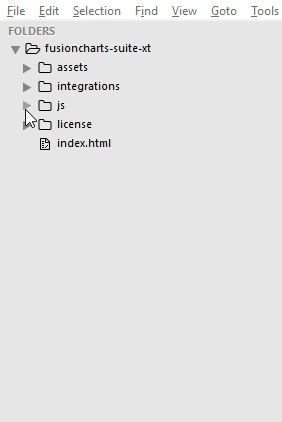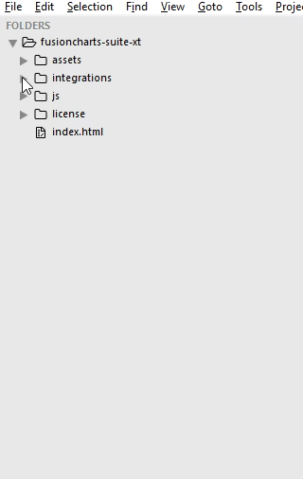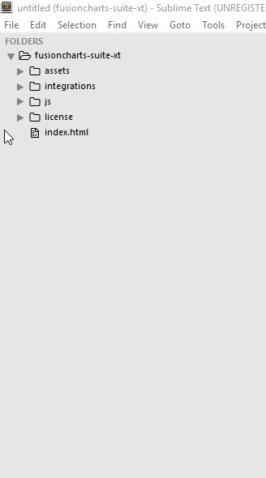Installation
The Vue-FusionCharts wrapper lets you include FusionCharts in your Vue projects and add interactive JavaScript charts and graphs to your Vue applications. Before we start the installation process of the wrapper, some of the features of Vue-FusionCharts are:
- Easily create charts in JavaScript using your Vue code.
- Render charts using "props" binding. There are more than 50 props that you can use.
- Accepts data in three formats:
- JSON
- XML
- A URI pointing to a file containing JSON/XML data. However, each chart/map expects data to be formatted in a specific manner, and the data you provide must comply with the required format.
In this article, we will show you how to download and install the Vue-FusionCharts wrapper and all the other dependencies on your system.
Choose your mode of installation:
You can install FusionCharts in your Vue project using any of the two modes given below:
Install using Direct JavaScript files
In order to install and start working with Vue-FusionCharts you need to download the FusionCharts Suite XT package which contains:
- JavaScript files to render Charts, Widgets and PowerCharts in the
jsfolder. - JavaScript files to render maps in the
js > mapsfolder. - JavaScript files to apply themes in the
js > themesfolder.
The folder structure is shown below:

We recommend that you copy all the files/folders from
fusioncharts-suite-xt > jsfolder to your project folder.
- The download package also contains files of the
vue-fusionCharts.jsfile infusioncharts-suite-xt > integrations > vuefolder.
The folder structure is shown below:

Both the minified (compressed) and source (uncompressed) copies of Vue files are available in the folder. The uncompressed file vue-fusioncharts.js is used during development or debugging, whereas the compressed file vue-fusioncharts.min.js saves bandwidth and improves performance in production. The folder also contains the source map file vue-fusioncharts.js.map, for use when debugging with a compressed file.
The
vuefolder in the FusionCharts Suite XT package is available from v3.13.0.
We recommend that you copy the JavaScript files of the
vuefolder fromfusioncharts-suite-xt > integrations > vue > jsto your project folder.
Following is the list of JavaScript files present in your fusioncharts-suite-xt > js folder:
| File Name | Description | |
|---|---|---|
fusioncharts.js |
This is the core FusionCharts library, which you need to import in all your pages where you want to generate a chart, gauge or a map. | |
fusioncharts.charts.js |
This file is required to render all charts present under FusionCharts XT. Note: When you include fusioncharts.js file in your page, you do not need to include this file separately, as fusioncharts.js internally loads fusioncharts.charts.js provided they are in the same folder. |
|
fusioncharts.widgets.js |
This file is required to render all gauges present under FusionWidgets XT. Note: When you include fusioncharts.js file in your page, you do not need to include this file separately, as fusioncharts.js internally loads fusioncharts.widgets.js provided they are in the same folder. |
|
fusioncharts.powercharts.js |
This file is required to render all charts present under PowerCharts XT. Note: When you include fusioncharts.js file in your page, you do not need to include this file separately, as fusioncharts.js internally loads fusioncharts.powercharts.js provided they are in the same folder. |
|
fusioncharts.gantt.js |
This file is required to render the Gantt chart. Note: When you include fusioncharts.js file in your page, you do not need to include this file separately, as fusioncharts.js internally loads fusioncharts.gantt.js provided they are in the same folder. |
|
fusioncharts.treemap.js |
This file is required to render the Treemap. Note: When you include fusioncharts.js file in your page, you do not need to include this file separately, as fusioncharts.js internally loads fusioncharts.treemap.js provided they are in the same folder. |
|
fusioncharts.zoomscatter.js |
This file is required to render the Zoom scatter chart. Note: When you include fusioncharts.js file in your page, you do not need to include this file separately, as fusioncharts.js internally loads fusioncharts.zoomscatter.js provided they are in the same folder. |
|
fusioncharts.zoomline.js |
This file is required to render the Zoom line charts. Note: When you include fusioncharts.js file in your page, you do not need to include this file separately, as fusioncharts.js internally loads fusioncharts.zoomline.js provided they are in the same folder. |
|
fusioncharts.overlappedbar2d.js |
This file is required to render the Overlapped Bar 2D chart. Note: When you include fusioncharts.js file in your page, you do not need to include this file separately, as fusioncharts.js internally loads fusioncharts.overlappedbar2d.js provided they are in the same folder. |
|
fusioncharts.overlappedcolumn2d.js |
This file is required to render the Overlapped Column 2D chart, present under FusionCharts XT. Note: When you include fusioncharts.js file in your page, you do not need to include this file separately, as fusioncharts.js internally loads fusioncharts.overlappedcolumn2d.js provided they are in the same folder. |
|
fusioncharts.maps.js |
This file is the core map renderer file. The map definitions, however, are stored separately, as explained next. Note: When you include fusioncharts.js file in your page, you do not need to include this file separately, as fusioncharts.js internally loads fusioncharts.maps.js provided they are in the same folder. |
|
maps/* |
This folder contains Map Definition files required by each map to be rendered by fusioncharts.maps.js. To keep the download package size small, it contains only 2 maps - fusioncharts.world.js and fusioncharts.usa.js. You can download the definition files of all the 1400+ maps offered by FusionMaps XT from here . Note: Replace the map definition files (of v3.12.2 or older) with the latest files available in download package while upgrading to v3.13.0. |
|
themes/* |
This folder contains pre-packaged themes that can be applied to charts, gauges, and maps to style them through a central FusionCharts theme files. Refer each theme with their respective JavaScript file names. |
To install FusionCharts Suite XT, simply copy and paste the JavaScript files from the downloaded package into your project folder.
After that, you can include the file in your web applications and start building your charts, gauges, and maps.
Create an HTML file and follow the steps given below:
Step 1: Include Vue core library:
<script type="text/javascript" src="path/to/local/vue.js"></script>Step 2: Include the vue-fusioncharts module:
<script type="text/javascript" src="path/to/local/vue-fusioncharts.js"></script>Step 3: Include the FusionCharts package:
<script type="text/javascript" src="path/to/local/fusioncharts.js"></script>Step 4 (optional): Include the theme file.
<script type="text/javascript" src="path/to/local/fusioncharts.theme.fusion.js"></script>The consolidated code is shown below:
<head>
<meta charset="utf-8">
<title>Vue - FusionCharts</title>
<!-- vue -->
<script type="text/javascript" src="path/to/local/vue.js"></script>
<!-- FusionCharts -->
<script type="text/javascript" src="path/to/local/fusioncharts.js"></script>
<!-- Vue-FusionCharts -->
<script type="text/javascript" src="path/to/local/vue-fusioncharts.js"></script>
<!-- Fusion Theme -->
<script type="text/javascript" src="path/to/local/fusioncharts.theme.fusion.js"></script>
</head>This completes the installation of FusionCharts in your application. To see how to create a chart, click here .
Installing FusionMaps for your project
FusionCharts Suite XT provides 1400+ data-driven maps as a part of the FusionMaps product.
To reduce the size of the download package, we have included the fusioncharts.maps.js file and only two map definition files - the World Map, and the map of USA. However, you can download the rest the of map definition files to plot maps of those countries/regions.
If you are using version v3.12.2 or older, download the latest version and replace for upgrading to the latest map definition files.
To render a map, you need the core FusionCharts library fusioncharts.js along with fusioncharts.maps.js, vue.js, and the map definition files as shown below:
<script type="text/javascript" src="path/to/local/vue.js"></script>
<script type="text/javascript" src="path/to/local/fusioncharts.js"></script>
<script type="text/javascript" src="path/to/local/fusioncharts.maps.js"></script>
<script type="text/javascript" src="path/to/local/maps/fusioncharts.world.js"></script>In the above example, we’ve included the World Map whose map definition (path) is contained in maps/fusioncharts.world.js.
Load other map definition files
To use any other map (except World and USA) from the 1400+ maps, download the map definition files, then copy those map files to your current maps folder. The map definition files are named in the fusioncharts.[MAP_ALIAS].js format, where MAP_ALIAS represents the country, state, or region name.
<script type="text/javascript" src="path/to/local/maps/fusioncharts.[MAP_ALIAS].js"></script>Therefore, assuming you need to render the map of California, the alias name california replaces MAP_ALIAS in the format as shown below:
<script type="text/javascript" src="path/to/local/maps/fusioncharts.california.js"></script>Click here to explore all the maps available in FusionMaps XT.
The consolidated code (including the vue.js, fusioncharts.js and vue-fusioncharts.js) is shown below:
<head>
<meta charset="utf-8">
<title>Vue - FusionCharts</title>
<!-- vue -->
<script type="text/javascript" src="path/to/local/vue.js"></script>
<!-- FusionCharts -->
<script type="text/javascript" src="path/to/local/fusioncharts.js"></script>
<!-- Vue-FusionCharts -->
<script type="text/javascript" src="path/to/local/vue-fusioncharts.js"></script>
<!-- FusionMaps -->
<script type="text/javascript" src="path/to/local/fusioncharts.maps.js"></script>
<!--world -->
<script type="text/javascript" src="path/to/local/fusioncharts.world.js"></script>
</head>Themes
Themes shipped with FusionCharts Suite XT allow you to apply centralized themes to any number of charts.
In a theme file, we can centralize the following aspects of all of your charts, gauges and maps:
- Visual appearance (data plot color, font color, font size, etc.)
- Behavior (hover effects for data plots)
- Intelligence (applying different colors to the positive and negative data plots in all charts that use the theme)
The FusionCharts Suite download package also contains predefined theme files under fusioncharts-suite-xt > js > themes folder. The folder structure is shown below:

To add a theme to your chart, include its corresponding JavaScript file in your HTML page as shown in the code below:
<script type="text/javascript" src="path/to/local/fusioncharts.js"></script>
<script type="text/javascript" src="path/to/local/themes/fusioncharts.theme.fusion.js"></script>Only including the
fusioncharts.theme.fusion.jsfile will not apply the theme. To apply the theme, set the value ofthemeattribute to the respective name of the theme. For more details click here .
Include FusionCharts via npm
The fusioncharts package contains files for all charts and widgets and only two map definition files, for the World map and the USA map.
This section outlines the steps to be executed for installing all the node modules via npm and rendering charts using the vue-fusioncharts component.
Step 1: Install the vue-fusioncharts module via npm
$ npm install vue-fusioncharts --saveStep 2: Install fusioncharts package
$ npm install fusioncharts --saveStep 3: Include the vue component
import Vue from 'vue';Step 4: Include 'vue-fusioncharts' component
import VueFusionCharts from 'vue-fusioncharts';Step 5: Include fusioncharts core library
import FusionCharts from 'fusioncharts/core';Step 6: Include specific chart modules
import Column2D from 'fusioncharts/viz/column2d';Step 7: Register the VueFusionCharts component:
Globally
In your JavaScript code, use the Vue.use() method to register the vue-fusioncharts component globally. This allows you to use them in the template of any root Vue instance created after registration.
Vue.use(VueFusionCharts, FusionCharts, Column2D);Locally
Registering components globally ensures that even if you want to stop using them, they will be a part of your final build. This results in an increase in JavaScript code that the users have to download. To avoid bloated code, we recommend registering the component locally.
In your JavaScript code, use the Vue.component() method to register the vue-fusioncharts component locally. Use Vue.component() instead of Vue.use(), the rest of the code remains same. Refer to the code below:
Vue.component('fusioncharts', VueFusionCharts, FusionCharts, Column2D);The consolidated code is shown below:
import Vue from 'vue';
import VueFusionCharts from 'vue-fusioncharts';
import FusionCharts from 'fusioncharts/core';
import Column2D from 'fusioncharts/viz/column2d'
// Register VueFusionCharts component
Vue.use(VueFusionCharts, FusionCharts, Column2D)
var app = new Vue({
el: '#app',
data: {
width: '700',
height: '400',
type: 'column2d',
dataFormat: 'json',
dataSource: {
"chart": {
"caption": "Countries With Most Oil Reserves [2017-18]",
"subCaption": "In MMbbl = One Million barrels",
"xAxisName": "Country",
"yAxisName": "Reserves (MMbbl)",
"numberSuffix": "K",
"theme": "fusion"
},
"data": [{
"label": "Venezuela",
"value": "290"
}, {
"label": "Saudi",
"value": "260"
}, {
"label": "Canada",
"value": "180"
}, {
"label": "Iran",
"value": "140"
}, {
"label": "Russia",
"value": "115"
}, {
"label": "UAE",
"value": "100"
}, {
"label": "US",
"value": "30"
}, {
"label": "China",
"value": "30"
}]
}
}
});The HTML template to render the chart is given below:
<div id="app">
<fusioncharts
:type="type"
:width="width"
:height="height"
:dataFormat="dataFormat"
:dataSource="dataSource"
></fusioncharts>
</div>Include Maps via npm
The fusioncharts package contains only two map definition files in fusioncharts/maps directory, the World Map and the Map of USA. This is done to keep the package lightweight. To use any of these two map definition files, follow the steps given below:
Step 1: Load fusioncharts module
import FusionCharts from 'fusioncharts/core'Step 2: Load the FusionMaps renderer and the map definition file
import FusionMaps from 'fusioncharts/maps';
import World from 'fusioncharts/maps/es/fusioncharts.world';Step 3: Register the VueFusionCharts component:
Globally
In your JavaScript code, use the Vue.use() method to register the vue-fusioncharts component globally. Registering the component globally allows you to use them in the template of any root Vue instance created after registration.
Vue.use(VueFusionCharts, FusionCharts, FusionMaps, World);Locally
Registering components globally ensures that even if you want to stop using them, they will be a part of your final build. This results in an increase in JavaScript code that the users have to download. To avoid bloated code, we recommend registering the component locally.
In your JavaScript code, use the Vue.component() method to register the vue-fusioncharts component locally. To register locally, use Vue.component() instead of Vue.use(), the rest of the code remains same. Refer to the code below:
Vue.component('fusioncharts', VueFusionCharts, FusionCharts, FusionMaps, World);The consolidated code to render the World map is shown below:
import Vue from 'vue';
import VueFusionCharts from 'vue-fusioncharts';
import FusionCharts from 'fusioncharts/core';
import FusionMaps from 'fusioncharts/maps';
import World from 'fusionmaps/maps/es/fusioncharts.world';
// Register VueFusionCharts component
Vue.use(VueFusionCharts, FusionCharts, Maps, World)
var app = new Vue({
el: '#app',
data: {
width: '800',
height: '550',
type: 'world',
dataFormat: 'json',
dataSource: {
// Map Configuration
"chart": {
"caption": "Average Annual Population Growth",
"subcaption": " 1955-2015",
"numbersuffix": "%",
"includevalueinlabels": "1",
"labelsepchar": ": ",
"entityFillHoverColor": "#FFF9C4",
"theme": "fusion"
},
// Aesthetics; ranges synced with the slider
"colorrange": {
"minvalue": "0",
"code": "#FFE0B2",
"gradient": "1",
"color": [{
"minvalue": "0.5",
"maxvalue": "1.0",
"color": "#FFD74D"
}, {
"minvalue": "1.0",
"maxvalue": "2.0",
"color": "#FB8C00"
}, {
"minvalue": "2.0",
"maxvalue": "3.0",
"color": "#E65100"
}]
},
// Source data as JSON --> id represents countries of world.
"data": [{
"id": "NA",
"value": ".82",
"showLabel": "1"
}, {
"id": "SA",
"value": "2.04",
"showLabel": "1"
}, {
"id": "AS",
"value": "1.78",
"showLabel": "1"
}, {
"id": "EU",
"value": ".40",
"showLabel": "1"
}, {
"id": "AF",
"value": "2.58",
"showLabel": "1"
}, {
"id": "AU",
"value": "1.30",
"showLabel": "1"
}]
}
}
});The HTML template to render the map is given below:
<div id="app">
<fusioncharts
:type="type"
:width="width"
:height="height"
:dataFormat="dataFormat"
:dataSource="dataSource"
></fusioncharts>
</div>Load other map definition files
You can use the remaining map files, other than the World Map and the Map of USA that are shipped with the fusioncharts package. To do this, install the fusionmaps package which contains all the map definition files, as shown below:
Install the fusionmaps package
$ npm install fusionmapsOnce the fusionmaps package is installed you will find all the map definition files in fusionmaps/maps/es folder.
The
fusionmapspackage is dependent on thefusionchartspackage. Therefore, to use FusionMaps, it is necessary to first includefusionchartsand the map renderer as shown below:
import FusionCharts from 'fusioncharts/core'
import FusionMaps from 'fusioncharts/maps';Load the map definition file(s) from the fusionmaps package for the map(s) to be rendered using the format: fusioncharts.<MAP_ALIAS>.
Click here to get the alias names for all map definition files.
Therefore, assuming you need to render the map of California, the alias name california replaces MAP_ALIAS in the format. So, the complete format will be fusioncharts.california.
import FusionCharts from 'fusioncharts/core';
import FusionMaps from 'fusioncharts/maps';
import California from 'fusionmaps/maps/es/fusioncharts.california';Register the VueFusionCharts component:
Globally
In your JavaScript code, use the Vue.use() method to register the vue-fusioncharts component globally. This allows you to use them in the template of any root Vue instance created after registration.
Vue.use(VueFusionCharts, FusionCharts, FusionMaps, California);Locally
Registering components globally ensures that even if you want to stop using them, they will be a part of your final build. This increases the JavaScript code that users have to download. To avoid bloated code, we recommend registering the component locally.
In your JavaScript code, use the Vue.component() method to register the vue-fusioncharts component locally. Use Vue.component() instead of Vue.use(), the rest of the code remains same. Refer to the code below:
Vue.component('fusioncharts', VueFusionCharts, FusionCharts, FusionMaps, California);It is mandatory to include the map definition files for all maps that you want to render in your application. Unlike the core files stored in the
fusionchartsdirectory, all map definition files are stored in themapsdirectory and are fetched from there.
Include Themes via npm
Themes shipped with FusionCharts Suite XT allow you to apply centralized themes to any number of charts.
In a theme file, we can centralize the following aspects of all of your charts, gauges and maps:
- Visual appearance (data plot color, font color, font size, etc.)
- Behavior (hover effects for data plots)
- Intelligence (applying different colors to the positive and negative data plots in all charts that use the theme)
To include the definition files placed in fusioncharts/themes, follow the steps shown below:
In your JavaScript code, use the Vue.use() method to register the vue-fusioncharts component.
Step 1: Include the core FusionCharts files
import FusionCharts from 'fusioncharts/core'Step 2: Include the theme file
import FusionTheme from 'fusioncharts/themes/es/fusioncharts.theme.fusion'Step 3: Register the VueFusionCharts component:
Globally
Vue.use(VueFusionCharts, FusionCharts, FusionTheme);Locally
Vue.component('fusioncharts', VueFusionCharts, FusionCharts, FusionTheme);Only including the
fusioncharts.theme.fusion.jsfile will not apply the theme. To apply the theme, set the value ofthemeattribute to the respective name of the theme. For more details click here .